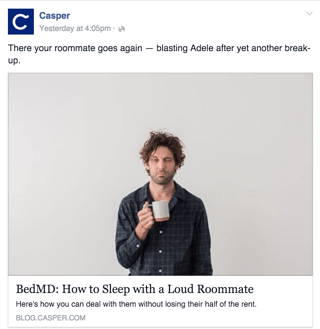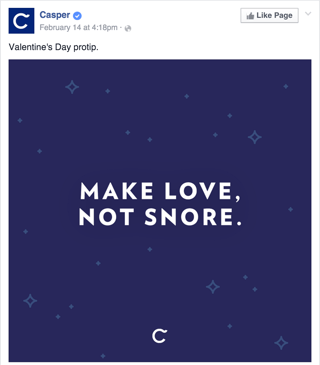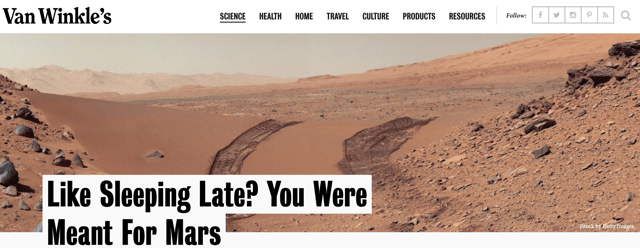Welcome back to our new series, Content Marketing Deep Dive, where we examine successful brands that consistently produce examples of great content marketing. We'll cover what each brand does well and what you can learn from them, with 3 key takeaways you can begin applying to your content marketing efforts.
This week we're taking a look at Casper mattresses. I loved doing this analysis, not only because Casper does such a great job with their content marketing, but also because they're a great example of a brand that has leveraged content marketing to make a business that you would typically think of as selling a "boring" product, into something that's fun and interesting.
Here are 3 key insights from Casper you can apply right now:
Insight 1: Tackle Related Topics
"If you're a potential customer in the Awareness stage, you're not going to be searching for the best mattress, or maybe for anything to do with a mattress at all yet."
Casper does a great job of writing about a ton of topics that aren't necessarily what you might first think of when you're promoting a mattress, like "What to do When Your Partner Snores" or "8 Things You Should Watch on the Internet If You Can't Sleep."
None of these topics are focused directly on the product Casper sells, but they are solutions to problems that people who would like a better mattress might be having, like difficulty sleeping. Not only are they creating educational content, but Casper's digital marketing team is also writing content that will speak to people who are in that first stage of the buyer's journey, Awareness.
People in the Awareness stage know that they have a problem, but they aren't quite sure yet what it is and how they intend to solve it, and they're starting to try to figure that out. If you're a potential customer in the Awareness stage, you're not going to be searching for the best mattress, or maybe for anything to do with a mattress at all yet. However, you might be searching for answers to other sleep related problems.

Image credit: Casper Facebook Page
As noted in the comments, it's not a great idea to sleep with your roommate, loudly or otherwise.
KEY TAKEAWAYS FOR YOUR BRAND
- Increase visibility - Writing content loosely related to your product or service can make you easier to find for people who have a problem you can solve, but don't know what their problem is yet.
- Simplify content creation - Let's face it, no matter how great a mattress is, there are only so many blog posts, videos, etc that you can create about it. Not only does talking about related topics provide better tangible results, it also makes it easier to consistently produce great content.
- Be entertaining - As important as education is to content marketing, it is still just one part of your content strategy. You can't just be informative, you also have to be entertaining. As is the case with Casper's list of things to watch on the Internet if you can't sleep, related topics give you an opportunity to step back from being educational and focus on being entertaining. (Though I still believe your brand is at it's best when it's being both all at once)
Insight 2: Create Culturally Relevant Content
Even if your brand isn't culturally relevant, it doesn't mean that you can't create content that is. As you see with Casper's play on words with a popular 60's era counterculture anti-war slogan, when you do this right, you'll get great results. This particular post was shared 264 times!

Image credit: Casper Facebook Page
Of course the risk in doing this poorly is that you end up on one of those lists of the worst social media/digital marketing/human beings of [insert date].
It isn't really all that complicated though. If you follow the three steps below, you'll pull this off without a hitch.
KEY TAKEAWAYS FOR YOUR BRAND
- Don't be exploitative - People often talk about what is and isn't "offensive" when talking about poorly executed attempts at a post like this. That's a very broad and vague term though. What is and isn't offensive? What's more relevant is to dig into why those posts are offensive. The answer is that they're exploiting someone else, be it veterans, mass shooting/natural disaster victims, minorities, in an attempt to get a laugh or drive interactions on content. If you're being culturally relevant without exploiting a tragedy or someone else's misfortune, then you should be fine.
- Be funny or have a unique perspective - Who cares if content has cultural relevance if it isn't interesting? The obvious route is to make your content funny. Another great opportunity for shareable, culturally relevant content is to share a new perspective that nobody else has thought of yet. Matthew Patrick's Film Theory YouTube Channel is a great example of this. He looks at popular movies from a new perspective, with theories that make you rethink perceived plot inconsistencies and how they might actually tie into a narrative within the story that you never noticed.
- Be concise - This post is just 4 words on a background image. That's all it took to bring a few seconds of joy to thousands of people's days and get 264 of them to share that post. Content like this needs to be skimmable and shareable. That means short and right to the point.
Insight 3: Leverage Unbranded Content Hubs
The reality of the world we market in is that people don't trust brands as much as other sources. As I noted upfront in my interview with Kentico CEO Petr Palas a little over a year ago, people don't trust branded content as much as they do other sources that they see, rightly or wrongly, as more objective.
Considering that 92% of people say they trust earned media, it's not surprising to see brands like Casper building unbranded or minimally branded content hubs. While this isn't really earned media, without a company's logo at the top of the page, the reality is that many people will feel better about what they're reading and better about sharing it with others.
Casper has created Van Winkle's as a hub for content on multiple topics and how they relate to getting a good night's rest.

Image Credit: Van Winkles.com
"The broad goal of the Casper site is to “own the conversation around sleep,” Ms. Kaplan said. That might mean analyzing the science of dreaming, the effects of drug-use on sleep, or how sleep affects workplace productivity."Interview with Lindsay Kaplan, VP of Comms at Casper on The Wall Street Journal.com
Of course there's a lot of potential for abuse here, such as recommending the brand's products or services without revealing the true nature of where those endorsements are coming from. Looking at the online relationship between Casper's branded content and social accounts and their Van Winkle's counterparts, while Casper does share content from their Van Winkle's media hub, there's no evidence of sneaky cross-promotion of Casper products in their Van Winkle's content.
That's smart, by focusing on the long term rewards from building an unbranded content hub and not the potential short term benefits of using it to promote Casper products directly, they're protecting the trust that their customers and Van Winkle's readers put in them.
KEY TAKEAWAYS FOR YOUR BRAND
Why is unbranded publishing such a strong tool in content marketing?
- Trust - As long as you're not abusing an unbranded content hub to self-promote under the guise of being a third party, minimally branded content is more likely to be trusted and shared by readers.
- Practicality - Having a place for content to live that isn't on an official company domain can give a digital marketing team a lot more freedom in the content they post or share. This can be especially beneficial in a large corporation with an extended approval process, excessive push back from legal, or other red tape that makes effective, consistent content marketing difficult.
- Experimentation - In a similar vein, for teams that do have more latitude over the content review process but want to take risks, try new ways to distribute content, or feature more content written by 3rd parties or customers that might not be a good fit for a branded channel, unbranded content provides a great opportunity to experiment. Fashion label Wren is a great example of this, with their controversial minimally branded video that increased sales by 1400% following the campaign.
The broad goal of the Casper site is to “own the conversation around sleep,” Ms. Kaplan said. That might mean analyzing the science of dreaming, the effects of drug-use on sleep, or how sleep affects workplace productivity.
Want to learn more about how to consistently create high quality content for your blog, Facebook Page, or other social communites? Check out our Ultimate Guide to Content Marketing in 2016 and download our ebook on How to Write Great Blog Posts!
➤ UPDATE - Hear more about this blog post in Fresh Thoughts Podcast Ep 05 - Multiple Facebook Pages and Content Marketing Deep Dives.
Tags:
Content MarketingFeb 24, 2016


